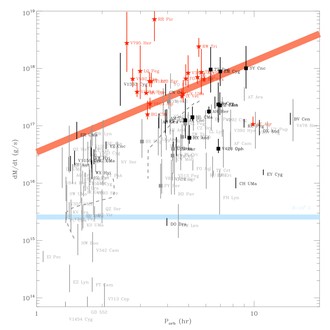

Cataclysmic variable stars (CVs) are binary systems composed of a white dwarf accreting from a low-mass stellar companion filling its Roche lobe. CVs come in a bewildering variety of types and subtypes corresponding to their variability properties and spectra. The overarching distinction is between the dwarf novae, which show repeated outbursts with an amplitude larger than 2 optical magnitudes on timescales of weeks to decades, and the nova-like systems, whose brightness remains roughly steady on the same timescales.
The outbursts of dwarf novae originate in the accretion disc surrounding the white dwarf, due to an instability occurring when the temperature is low enough for hydrogen to recombine. The steep dependence of the opacity with temperature in this regime triggers a thermal and a viscous instability that leads the disc to cycle through two states. In the eruptive state, the disc has a high temperature larger than 10 000 K, hydrogen is highly ionised, and the mass accretion rate Ṁ is higher than the mass transfer rate from the companion star. In the quiescent state, the disc has a temperature less than 3000 K, hydrogen is mostly neutral, and Ṁ is lower than the mass-transfer rate. The disc instability model (DIM) explores the consequences of this instability by the describing the light-curves of dwarf-nova stars.
A fundamental test of the DIM is whether it reproduces the distinction between dwarf novae and nova-likes. In nova-likes, the whole disc should be hot enough for hydrogen to be highly ionised. This translates into a minimum mass accretion rate above which a disc of given size is stable. The system is a dwarf nova if this criterion is not met. Hence, the DIM can be tested against observations by deriving the average mass accretion rate and the size of the disc Rdisc in dwarf novae and nova-likes.
In 1982 professor Józef Smak, from the Nicolaus Copernicus Astronomical Center of the Polish Academy of Sciences, one of the authors of the DIM, showed that this criterion roughly separates nova-likes from dwarf novae in the Rdisc - Ṁ plane, using approximate magnitudes and distances for a dozen CVs thus providing an argument in favour of correctness of the model.
Thirty-six years later, Guillaume Dubus from the Planetology and Astrophysics Institute in Grenoble, Magdalena Otulakowska-Hypka from the Astronomical Observatory of the University of Poznań and Jean-Pierre Lasota, from the Nicolaus Copernicus Astronomical Center and the Institute of Astrophysics in Paris, have repeated professor Smak's exercise, but this time with a sample of 130 CVs whose parallax distances were taken from the recent Gaia DR2 catalogue. These very precise distances allow an exact determination of the CV's accretion rate. The results are a splendid and final confirmation of the validity of disc instability model as a description of dwarf-nova outbursts.
Figure caption: Mass transfer rates of cataclysmic variables compared to the stability criterion. Upper figure (Smak 1982): The three borderlines correspond to white dwarf masses equal (from to bottom) 0.5, 1.0, 1.2 M⦿. Shaded boxes represent nova-like objects; unshaded boxes are dwarf novae. DQ=DQ Her, U=U Gem, Z=Z Cha, USP DN=Ultra Short Period DN, S=Stepanyan star (now called IP Peg - its correct period is 3.80 hr, so the disc radius should be about 8 1010 cm, i.e. in the unstable region. We know now that IP Peg is a dwarf nova!).Lower figure (Dubus et al. 2018): Systems above the (red) upper solid line are hot and stable. Systems below the lower (blue) line will be cold, stable discs if the white dwarf magnetic field larger that 10 T. Dashed line is the expected secular mass transfer rate from evolutionary models by Knigge et al (2011). Square symbols indicate Z Cam type dwarf novae, (red) stars indicate nova-likes. The orbital period Porb is proportional to Rdisc3/2.
Dubus, Guillaume; Otulakowska-Hypka, Magdalena; Lasota, Jean-Pierre 2018, Astronomy and Astrophysics, in press;
(Knigge, C., Baraffe, I., & Patterson, J. 2011, ApJS, 194, 28)






